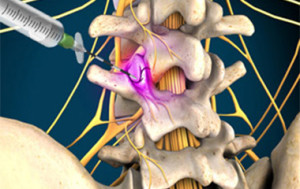What is Facet Radiofrequency Injection?
A radiofrequency injection is a type of injection procedure. It’s used to treat facet joint or sacroiliac joint pain caused by arthritis or other degenerative changes, or from injury.
In this procedure, a heat lesion is created on certain nerves with the goal of interrupting the pain signals to the brain, thus eliminating pain.
There are two primary types of radiofrequency injections:
- A medial branch neurotomy (ablation) affects the nerves carrying pain from the facet joints
- A lateral branch neurotomy (ablation) affects nerves that carry pain from the sacroiliac joints.
These medial or lateral branch nerves do not control any muscles or sensation in the arms or legs. Making it so a heat lesion poses little danger of negatively affecting those areas. The medial branch nerves do control small muscles in the neck and lumbar, but loss of these nerves hasn’t proved harmful.
Medial Branch/Lateral Branch Nerve Block
Before the radiofrequency ablation procedure, a lateral branch or medial branch nerve block will have already been performed. This is done to prove that the patient’s pain is being transmitted by those nerves. The medial branch or lateral branch block acts as a test run before the neurotomy procedure.

The radiofrequency injection procedure is designed to treat lower back pain originating from either facet joint or sacroiliac joint problems.
Radiofrequency Ablation Success Rates
Success rates vary, but typically about 30% to 50% of patients undergoing this procedure for low back pain will experience significant pain relief for as much as two years. Of the remaining low back pain patients, about 50% will get some pain relief for a shorter period.
Some patients do not experience any relief from pain as a result of this procedure.
Overall, success rates are greater in the cervical spine (neck) than in other areas.
As a general rule, if effective, the ablation will often provide pain relief lasting at least 9 to 14 months and sometimes for longer. After this period of time, however, the nerve will regenerate and the pain may return.
Joints Treated with Radiofrequency Ablation
Joint arthritis, degeneration, or injury can lead to spine pain and limited range of motion. The joints treated with radiofrequency ablation are:
- Facet joints – pairs of small joints that are situated at each vertebral level in the back of the spine. Each facet joint is connected to 2 medial branch nerves that carry signals (including pain signals) away from the spine to the brain.
- Sacroiliac joints – joints located at the lowest part of the spine, between the sacrum and ilium in the pelvis, and are connected to lateral branch nerves that carry signals to the brain.
The radiofrequency ablation procedure is designed to treat lower back pain originating from either facet joint or sacroiliac joint problems.
The Radiofrequency Injection Procedure
As with many spinal injections, radiofrequency neurotomy is best performed under fluoroscopy (live x-ray) for guidance in properly targeting and placing the needle (and for avoiding nerve or other injury).
Radiofrequency Ablation Steps
The neurotomy or ablation procedure includes the following steps:
- An intravenous (IV) line is often started so that relaxation medicine (sedation) can be given.
- The patient lies on a procedure table and the skin over the neck, mid-back, or low back is well cleaned.
- The physician numbs a small area of skin with numbing medicine (anesthetic), which may sting for a few seconds.
- The physician uses x-ray guidance (fluoroscopy) to direct a special (radiofrequency) needle alongside the medial or lateral branch nerves.
- A small amount of electrical current is often carefully passed through the needle to assure it is next to the target nerve and a safe distance from other nerves. This current should briefly recreate the usual pain and cause a muscle twitch in the neck or back.
- The targeted nerves will then be numbed to minimize pain while the lesion is being created.
- The radiofrequency waves are introduced to heat the tip of the needle and a heat lesion is created on the nerve to disrupt the nerve’s ability to send pain signals.
- This process will be repeated for additional nerves.
The entire radiofrequency ablation procedure usually takes 30 to 90 minutes, and patients return home the same day.
On the day of the procedure, patients are advised to avoid driving and avoid doing any strenuous activities. Patients may continue to take any normal medications except aspirin, ibuprofen or any other blood-thinning medications, such as Coumadin.

